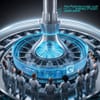Researchers at Massachusetts Institute of Technology (MIT) have developed a novel hybrid approach combining physics-based simulations and machine-learning techniques to better forecast how plasma behaves during shutdown (or "ramp-down") operations in tokamak-style fusion reactors. The focus is on improving safety and reliability in fusion power plants by reducing the risk of disruptions when transferring from high-energy plasma states to off states.
Why this matters: In tokamaks—heat-and-magnetically-confined reactors aiming to replicate the sun’s fusion process—the plasma can reach tens of millions of degrees and the currents flow at high speeds. MIT News When that plasma must be brought down (due to instability or end of pulse), controlling the ramp-down safely is critical: improper handling can damage reactor walls or internal components. The new model aims to predict potential instabilities during ramp-down and generate safe control “trajectories” to avoid damage.
Key innovation: Unlike pure machine-learning methods that require huge volumes of data, the MIT team paired a neural network with a physics-based simulation model of plasma dynamics. They used data from the Swiss “Variable Configuration Tokamak” (TCV) and found that only a few hundred low-performance pulses plus a handful of high-performance pulses sufficed to train the model with high accuracy. Moreover, they developed an algorithm that converts model predictions into actionable control instructions for the reactor – for example adjusting magnet or temperature settings – and demonstrated improved ramp-down performance in some test runs.
Implications: As fusion moves from experimental setups toward commercial-scale power plants, reliability and damage-prevention become major bottlenecks. The new approach helps by lowering one risk factor: safely shutting down high-energy plasma states. It suggests that future reactors might require fewer “dry runs” or shield replacements, which lowers operational cost and increases availability. For the broader energy transition, this is a concrete step toward making fusion a dependable contributor to clean energy.


